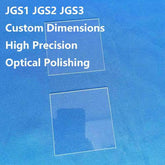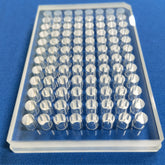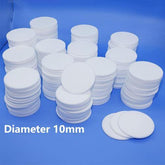What are the factors contributing to the fragility of quartz tubes during operation?
- Stress caused by thin film accumulation
When low-pressure chemical vapour deposition (LPCVD) technology is used in the fabrication of tunnel oxide layers and doped polysilicon layers, the interior of the quartz plate, quartz boat, and quartz tube will be wrapped due to the non-directional characteristics of the deposition film. As the production process continues, the thickness of the deposited film on the quartz tube increases, which may result in the occurrence of silicon cracking phenomena. Furthermore, this can result in the formation of particles within the deposited film or cause one end of the quartz tube to sag, leading to an uneven film thickness that could ultimately cause the quartz tube to break.
- Thermal stress
The quartz tube may rupture when subjected to prolonged operation at high temperatures, particularly during the boron expansion and oxidation process. This is due to the accumulation of thermal stress caused by the alternating temperature fluctuations during the entry and exit of the silicon wafers from the oven.

- Alkali metal pollution
At high temperatures, the quartz tube will undergo a chemical reaction with alkali metals, resulting in the formation of crystallization. These crystalline regions exhibit increased fragility, leading to the development of cracks. Potential sources of alkali metal contamination may include the following: inadequate pickling and cleaning of quartz tubes with high-purity water prior to use, or the failure of quartz manufacturers to wear gloves during the installation or packaging processes, which can lead to alkali metal pollution from contaminants such as sweat.
- Collisionsduring installation process
Due to the considerable weight of the quartz tube, the limited installation space and the elevated position of the machine, the tube is susceptible to damage during the installation process. Similarly, an improperly installed furnace door can also result in tube break.

- Raw materialof the quartz tube
The insufficient purity of the raw material used in quartz tube fabrication can lead to deformation at high temperatures. Alternatively, excessive surface repairs on the quartz tube—often involving the use of quartz rod fillers to address bubbles after melting—may introduce further complications. Because these quartz rods frequently do not share the same raw material composition as the original quartz tube, it easily results in incompatibility issues.

- Uneven wall thicknessof the quartz tube
During the drawing process of the quartz tube, anomalies such as wall deviation may occur. That is, some sections may exhibit significantly reduced wall thickness compared to standard levels. This wall deviation issue often persists through subsequent deep processing stages. Furthermore, some manufacturers compromise on quality for increased profit margins by producing quartz tubes with wall thicknesses below standard requirements, rendering these thinner sections more susceptible to stress and cracking.
- Chemical reaction
The chemical gases used in the low pressure chemical vapor deposition (LPCVD) process may have an erosion effect on the quartz tube material, and such prolonged exposure may ultimately result in cracks.






